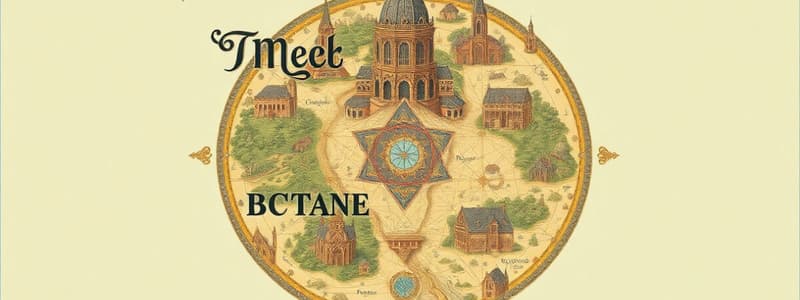Podcast
Questions and Answers
What is the primary characteristic of Gnomonic projection?
What is the primary characteristic of Gnomonic projection?
- It maintains angles from the tangent point. (correct)
- It displays all great circles as curved lines.
- It is primarily used for creating topographic maps.
- It distorts images significantly at the tangent point.
Which of the following is NOT a use of Gnomonic projection?
Which of the following is NOT a use of Gnomonic projection?
- Star charts
- Topographic mapping (correct)
- Seismic work
- Photography
Which statement about distortion in Gnomonic projection is true?
Which statement about distortion in Gnomonic projection is true?
- Distortion is negligible at all points on the map.
- No distortion occurs at the central point. (correct)
- Distortion decreases as you move away from the tangent point.
- Distortion is uniform across the entire map.
What does the term 'great circle' refer to in the context of Gnomonic projection?
What does the term 'great circle' refer to in the context of Gnomonic projection?
What is the primary drawback of using Gnomonic projection for mapping?
What is the primary drawback of using Gnomonic projection for mapping?
What is the main advantage of the Mercator projection?
What is the main advantage of the Mercator projection?
What causes distortion in a Gnomonic map of the world?
What causes distortion in a Gnomonic map of the world?
What is a significant drawback of the Mercator projection?
What is a significant drawback of the Mercator projection?
For what type of mapping is the Conic projection primarily used?
For what type of mapping is the Conic projection primarily used?
What defines a secant projection in Conic mapping?
What defines a secant projection in Conic mapping?
Flashcards
What is a Gnomonic projection?
What is a Gnomonic projection?
A map projection that displays all great circles as straight lines, showing the shortest route between any two points on the line.
What is the tangent point in a Gnomonic projection?
What is the tangent point in a Gnomonic projection?
The point on a Gnomonic projection where there is no distortion.
What is a great circle?
What is a great circle?
A great circle is the largest circle that can be drawn on a sphere. It is the intersection of a sphere and a plane that passes through the center of the sphere.
What are the uses of a Gnomonic projection?
What are the uses of a Gnomonic projection?
Signup and view all the flashcards
What is the main drawback of a Gnomonic projection?
What is the main drawback of a Gnomonic projection?
Signup and view all the flashcards
Gnomonic Projection
Gnomonic Projection
Signup and view all the flashcards
Tangent Point
Tangent Point
Signup and view all the flashcards
Mercator Projection
Mercator Projection
Signup and view all the flashcards
Conic Projection
Conic Projection
Signup and view all the flashcards
Standard Parallel
Standard Parallel
Signup and view all the flashcards
Study Notes
Map Projections
- Cartographers use various techniques to create maps that accurately represent the Earth's surface on a flat plane.
- Different projections preserve different aspects of maps, like angles, shapes, or distances.
- Common projections include Gnomonic, Mercator, and Conic.
Gnomonic Projection
- Displays great circles as straight lines, showing the shortest route between two points.
- Created by projecting points of a sphere onto a tangent plane.
- Distortion increases exponentially away from the tangent point (center of the map).
- Preserves angles (azimuthal projection) from the tangent point.
- Used for seismic work (seismic waves travel along great circles), photography (rectilinear projection), and star charts/astronomy (meteor paths).
- A great circle is also called an orthodrome; the largest circle that can be drawn on a sphere.
- Considered the oldest projection type, developed in the 6th century BCE for star charts.
- "Gnomonic" relates to sundials or telling time.
- Significant distortion away from the central point, making countries appear distorted in shape farther away.
Mercator Projection
- Conformal, cylindrical projection using longitude and latitude lines.
- Longitude lines are parallel and equally spaced meridians.
- Latitude lines are perpendicular and become farther apart near the poles.
- Preserves angles and shapes at an infinitesimal scale, so a straight line equals a compass bearing.
- Represents a globe wrapped in paper.
- Created by Gerardus Mercator in 1569.
- Originally designed for accurate compass bearings for sea travel.
- Distorts size to preserve shape, particularly problematic near the poles.
- Useful for large-scale maps of areas near the equator and for standard sea navigation charts.
- Often used in web maps and online services.
Conic Projection
- Projects images onto a cone.
- Projection is along a line of latitude (called the standard parallel).
- Meridians project across the cone.
- Latitude lines are projected as rings on the cone.
- Cone is cut, creating the final map.
- Distortion increases away from the standard parallel.
- Useful for midlatitude regions or maps of smaller portions of the Earth.
- More complex projections (secant projections) use two standard parallels.
- Commonly used for maps with east-west orientation.
- Suitable for road maps, weather maps, and smaller regions.
Studying That Suits You
Use AI to generate personalized quizzes and flashcards to suit your learning preferences.

